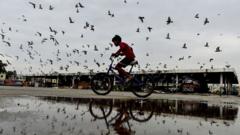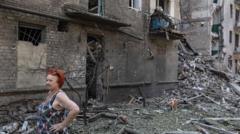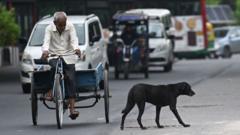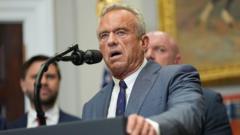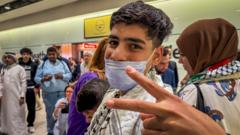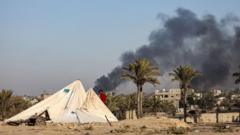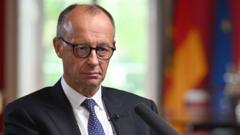The World Health Organization (WHO) reveals that measles cases in Europe have surged to their highest level in 25 years, linked to declining vaccination rates amidst a backdrop of skepticism towards immunization.
Alarming Rise in Measles Cases: A 25-Year High in Europe
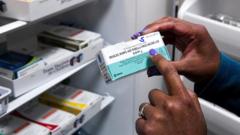
Alarming Rise in Measles Cases: A 25-Year High in Europe
WHO and UNICEF report a doubling of measles cases in Europe, with a significant drop in vaccination rates contributing to the resurgence.
The article text:
Measles has made a concerning comeback in Europe, with cases hitting their highest level in 25 years, according to a recent report from the World Health Organization (WHO) and UNICEF. The number of reported cases in the European region doubled last year, leading to grave health warnings from officials. “Measles is back, and it’s a wake-up call,” stated Hans Henri Kluge, WHO’s regional director for Europe. He emphasized that without high vaccination rates, the region is vulnerable to outbreaks and health risks.
Children under five years old were disproportionately affected, accounting for over 40% of the cases. The WHO reported 127,350 measles cases in Europe and central Asia up to 2024. This marks the highest figure since 1997, with 38 deaths reported up until early March 2025. After years of declining cases, a significant rise in infections began in 2018-19, exacerbated by lower vaccination coverage during the COVID-19 pandemic.
The MMR vaccine, a highly effective immunization against measles, mumps, and rubella, is crucial for preventing such outbreaks. Despite this, many European countries have yet to return to pre-pandemic vaccination levels, creating an increased risk for measles resurgence. Currently, the European region accounts for one-third of all global measles cases. Within this region, Romania has reported the highest number of cases, followed closely by Kazakhstan.
Concerns extend beyond Europe, as recent outbreaks have also occurred in the United States, which had previously considered measles eliminated in 2000. With two recent fatalities linked to the disease, the return of measles has sparked alarm about falling vaccination rates. Data shows that nearly 80% of individuals diagnosed with measles in the past year in Europe were unvaccinated. Alarmingly, only four countries—Hungary, Malta, Portugal, and Slovakia—have maintained vaccination coverage above the 95% threshold necessary to prevent outbreaks.
In the UK, similar concerns have arisen, with vaccination rates for the MMR vaccine dropping below 90%. Experts warn against misinformation spread via social media, highlighting the importance of relying on validated scientific information for vaccination decisions. Dr. Ben Kasstan-Dabush from the London School of Hygiene and Tropical Medicine cautioned, “Misinformation can travel rapidly and can influence people’s decisions.” The WHO and UNICEF’s findings emphasize the urgent need for governments to take decisive action to safeguard public health amid rising measles threats.
Measles has made a concerning comeback in Europe, with cases hitting their highest level in 25 years, according to a recent report from the World Health Organization (WHO) and UNICEF. The number of reported cases in the European region doubled last year, leading to grave health warnings from officials. “Measles is back, and it’s a wake-up call,” stated Hans Henri Kluge, WHO’s regional director for Europe. He emphasized that without high vaccination rates, the region is vulnerable to outbreaks and health risks.
Children under five years old were disproportionately affected, accounting for over 40% of the cases. The WHO reported 127,350 measles cases in Europe and central Asia up to 2024. This marks the highest figure since 1997, with 38 deaths reported up until early March 2025. After years of declining cases, a significant rise in infections began in 2018-19, exacerbated by lower vaccination coverage during the COVID-19 pandemic.
The MMR vaccine, a highly effective immunization against measles, mumps, and rubella, is crucial for preventing such outbreaks. Despite this, many European countries have yet to return to pre-pandemic vaccination levels, creating an increased risk for measles resurgence. Currently, the European region accounts for one-third of all global measles cases. Within this region, Romania has reported the highest number of cases, followed closely by Kazakhstan.
Concerns extend beyond Europe, as recent outbreaks have also occurred in the United States, which had previously considered measles eliminated in 2000. With two recent fatalities linked to the disease, the return of measles has sparked alarm about falling vaccination rates. Data shows that nearly 80% of individuals diagnosed with measles in the past year in Europe were unvaccinated. Alarmingly, only four countries—Hungary, Malta, Portugal, and Slovakia—have maintained vaccination coverage above the 95% threshold necessary to prevent outbreaks.
In the UK, similar concerns have arisen, with vaccination rates for the MMR vaccine dropping below 90%. Experts warn against misinformation spread via social media, highlighting the importance of relying on validated scientific information for vaccination decisions. Dr. Ben Kasstan-Dabush from the London School of Hygiene and Tropical Medicine cautioned, “Misinformation can travel rapidly and can influence people’s decisions.” The WHO and UNICEF’s findings emphasize the urgent need for governments to take decisive action to safeguard public health amid rising measles threats.

